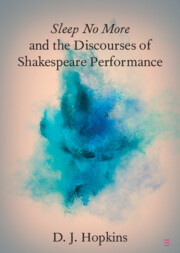486 results
La consolidación discursiva de la cisheteronormatividad a través de la marginalización del metrosexual, y las mujeres trans: El caso de la revista SoHo (1999–2014), Colombia
-
- Journal:
- Latin American Research Review ,
- Published online by Cambridge University Press:
- 24 May 2024, pp. 1-18
-
- Article
-
- You have access
- Open access
- HTML
- Export citation
Chapter 29 - Manuel Puig’s Circuit Bending: Literary Listening against Surveillance
- from Part III - Literary Names
-
-
- Book:
- A History of Argentine Literature
- Published online:
- 09 May 2024
- Print publication:
- 16 May 2024, pp 451-471
-
- Chapter
- Export citation
4 - Australia and Asia: A View From Europe
-
-
- Book:
- Australia in World Affairs 1991–1995
- Published online:
- 04 May 2024, pp 33-43
-
- Chapter
- Export citation
Chapter 1 - The Irish Revival and Yeats’s Literary Nationalism
-
- Book:
- Yeats, Revival, and the Temporalities of Irish Modernism
- Published online:
- 11 April 2024
- Print publication:
- 18 April 2024, pp 24-52
-
- Chapter
- Export citation
Imaginary work: media representations of work and gender in Italy from the economic miracle to the present day
-
- Journal:
- Modern Italy / Volume 29 / Issue 2 / May 2024
- Published online by Cambridge University Press:
- 15 April 2024, pp. 197-217
- Print publication:
- May 2024
-
- Article
-
- You have access
- Open access
- HTML
- Export citation
Gedächtnis trifft Einleitung. Ein neuer Blick auf alte Fragen
-
- Journal:
- New Testament Studies / Volume 70 / Issue 2 / April 2024
- Published online by Cambridge University Press:
- 03 June 2024, pp. 131-148
- Print publication:
- April 2024
-
- Article
-
- You have access
- Open access
- HTML
- Export citation
3 - The media and foreign policy
- from Part 1 - Australia and the World
-
-
- Book:
- Australia in World Affairs 1981–1990
- Published online:
- 29 March 2024, pp 51-62
-
- Chapter
- Export citation
“The Vital Link”: British Print Media Export to Australia, 1853–1980
-
- Journal:
- Enterprise & Society , First View
- Published online by Cambridge University Press:
- 11 March 2024, pp. 1-25
-
- Article
- Export citation
13 - Culture and Entertainment
- from Part II - Essential Signs
-
- Book:
- Chinese Signs
- Published online:
- 29 February 2024
- Print publication:
- 07 March 2024, pp 118-127
-
- Chapter
- Export citation
Legal entrepreneurship and the evolution of multidimensional advocacy in social movements: the case of marriage equality
-
- Journal:
- Law & Society Review / Volume 58 / Issue 1 / March 2024
- Published online by Cambridge University Press:
- 27 March 2024, pp. 95-125
- Print publication:
- March 2024
-
- Article
-
- You have access
- Open access
- HTML
- Export citation
4 - The Direct Line with Vladimir Putin
-
- Book:
- Dialogue with the Dictator
- Published online:
- 15 February 2024
- Print publication:
- 22 February 2024, pp 80-108
-
- Chapter
- Export citation
4 - The Control of Suicide Promotion over the Internet
-
- Book:
- Practical Ethics in Suicide
- Published online:
- 15 February 2024
- Print publication:
- 22 February 2024, pp 67-81
-
- Chapter
- Export citation
3 - The Citizen–Government Relationship in a Network of Trust Relationships
-
- Book:
- Trust, Courts and Social Rights
- Published online:
- 08 February 2024
- Print publication:
- 15 February 2024, pp 58-82
-
- Chapter
- Export citation
Chapter 1 - Methods Dialogue:
- from Part I - Planning
-
-
- Book:
- The Cambridge Guide to Mixed Methods Research for Theatre and Performance Studies
- Published online:
- 01 February 2024
- Print publication:
- 08 February 2024, pp 41-58
-
- Chapter
- Export citation
Anti-Immigrant Rhetoric and ICE Reporting Interest: Evidence from a Large-Scale Study of Web Search Data
-
- Journal:
- British Journal of Political Science / Volume 54 / Issue 3 / July 2024
- Published online by Cambridge University Press:
- 25 January 2024, pp. 748-770
- Print publication:
- July 2024
-
- Article
-
- You have access
- HTML
- Export citation

Sleep No More and the Discourses of Shakespeare Performance
-
- Published online:
- 24 January 2024
- Print publication:
- 22 February 2024
-
- Element
- Export citation
2 - Framing and Reframing Immigration
-
- Book:
- Immigration, Security, and the Liberal State
- Published online:
- 09 February 2024
- Print publication:
- 18 January 2024, pp 30-93
-
- Chapter
- Export citation
Suicide in the press: an analysis of newspaper coverage of adolescent versus adult suicides in Italy
-
- Journal:
- European Psychiatry / Volume 67 / Issue 1 / 2024
- Published online by Cambridge University Press:
- 17 January 2024, e9
-
- Article
-
- You have access
- Open access
- HTML
- Export citation
4 - The Public Forum
-
- Book:
- We Hold These Truths
- Published online:
- 30 November 2023
- Print publication:
- 21 December 2023, pp 98-135
-
- Chapter
- Export citation
Chapter 19 - Navigating Body Image
- from Part III - Evidence-Informed Considerations for Assessment and Treatment
-
- Book:
- Comorbid Eating Disorders and Obsessive-Compulsive Disorder
- Published online:
- 14 December 2023
- Print publication:
- 21 December 2023, pp 127-132
-
- Chapter
- Export citation



